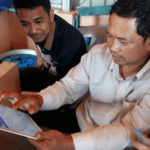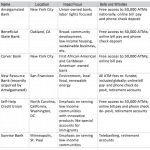Is Your Data Collection Program Ready to Go Mobile? Four Steps (And a Free Guide) to Help You Get Started
Last year, I wrote a NextBillion post about some of the benefits of mobile data collection, hoping to make two things clear.
First, the benefits of mobile data collection are significant – ranging from work automation and decision support, to multimedia communication with program beneficiaries. As I explained in the article, the more interactive experiences enabled by mobile tools offer value in the form of immediate feedback that can improve the relationship between frontline workers and beneficiaries.
But I also wanted to point out an equally important issue: As I put it in the post, “While the benefits of mobile data collection are clear, transitioning to a digital system is not as easy as simply digitizing existing paper forms.”
In the excitement about all the possibilities that mobile tools can offer, that last statement seems to be frequently ignored. Mobile data collection tools do have a lot to offer – but in the end, they are just tools. And sometimes you have to take a step back to see how the data collection side of your program might need to change to accommodate a digital system.
At Dimagi, we often have to explain to clients that even the best mobile data collection tools are not silver bullets. We have an entire team dedicated to helping organizations that want to change the structure of their programs to capture the greatest value from their mobile tools. But we can only directly support a limited number of the countless organizations that are beginning to explore mobile data collection. So we decided to compile some advice for organizations navigating the preliminary stages of a data collection-focused program, and to make it available as a free download for anyone to use.
This guide, “Data Collection: How to Get Started,” explores how to organize around a primary project objective, clarify what data you need to collect, assess your options for collection methods and develop a clear data collection plan. We’ve summarized each of these steps below.
Define your project objectives
A well-articulated project objective is a lens through which you can examine each step of your data collection program. It requires you to address a key challenge for all monitoring and evaluation professionals: cutting through the competing priorities, obstacles and stakeholders involved in a given project to pinpoint what your core objective should be.
In our experience, the right project objectives target issues that are urgent and clear to the community – whether that’s delivering healthcare to underserved regions, tracking crop yields, or measuring performance and attendance in schools.
As you work to define this, take note of which of your stakeholders have expressed interest in the issues you raise. If they haven’t expressed interest, find out why not, and adapt your objectives accordingly. You might find that other objectives are competing for stakeholders’ time and resources: If so, determine whether your project should refocus on those objectives – or if yours are urgent and vital enough to earn some of the available resources.
The process of turning a clear and urgent problem into precise project objectives is a crucial step to take before developing your data collection program, and it can be hard to get a project moving in the right direction without it. But once you have a clear destination, it is easier to determine whether a tool or initiative will take you closer to – or further away from – where you want to be.
Identify your data requirements
Once you have a core objective, the next question is how you can filter out the noise and focus on what you need to achieve it. A clear understanding of your data requirements will help narrow your focus, allowing you to identify a method of data collection that serves your needs precisely.
The first step in this process is to make a list of what data you know you need. Whether it’s based on results frameworks or requests from supervisors or funders – or built from scratch – outline an initial list of data requirements for your program. Then work to expand the list and describe each variable in more depth.
In most data collection and service delivery programs, the data can be broken down into two categories: program performance metrics and worker performance metrics. These two categories will help you identify the specific insights each variable will offer. Once you have categorized your data at this high level, you can ask more specific questions about each group of variables, to flesh out their attributes and characteristics. This step of the process should include your whole team, for a holistic view of what each variable will mean for your program.
Are your data quantitative, qualitative or a combination of the two? Are you collecting data from the same source over time (i.e. longitudinally)? Do certain variables depend on others? Each of the answers to these (and other) questions will reveal something different about the method of data collection your program will need to follow.
It won’t surprise you to know that data itself is the most important piece of any data collection program, so a comprehensive understanding of the data you need to collect is vital.
Determine your data collection method
The data you collect should inform everything about your program – so the method of data collection you use will have a substantial impact on your work. The characteristics of the data you need will help you choose a method, and each method has different strengths and weaknesses. For instance:
- How often you plan to collect data will determine whether you need one-off surveys or a case management system.
- The scale of your data collection program can help you figure out whether you can get away with a simple paper-based program, or if you would benefit from a mobile data collection or interactive voice response (IVR) program.
- More technical inputs, such as temperatures or longitude and latitude, will probably require you to utilize outside tools (i.e. heart rate monitors, GPS locators, etc.).
Review the characteristics of each variable to make sure the method you choose will actually help you collect the data you need.
Once you have listed, organized and described all these variables, you still need to account for where you are collecting the data, and from whom you are collecting it. What are the languages spoken by the people involved (both data collectors and beneficiaries)? What is the reading level or digital literacy level of your typical field worker? How extensive and reliable is mobile connectivity in the region?
Each of the answers to these questions has different implications for how you will need to set up your program. For instance, different languages mean you’ll need to translate forms, and low or no internet connection means you’ll need a data collection tool that works offline. In addressing these needs, we recommend collaborating with the local staff to overcome any challenges you face. It’s unlikely that this is the first time they are dealing with them.
The method of data collection that is right for your program is entirely dependent upon your program objectives and data requirements. Some programs might even call for a combination or hybrid of approaches to collect all the information you need. As you evaluate your options, always make sure that their strengths map back to your program objectives, and account for the characteristics of your data sources. Once you make your choice, it’s time to put all the pieces together.
Organize your data collection plan
A data collection plan is just that – a plan for how the information your program hopes to collect will generate actionable insights. The process of developing this plan will reveal things about where your data comes from, who has access to it, and how it is collected and stored – all of which are key pieces of information that will inform the design and implementation of any new system you choose.
We typically use one of two primary methods for organizing a data collection plan:
- An information workflow diagram, which lays out the components and their connections throughout your process in a visual way. These typically start by showing what data is being collected, then illustrate how it is collected, where it is stored, and how it is shared.
- A data collection plan outline is more analytical and applies a standard template to the process that you can fill out in a way that makes sense for your program. This approach helps organize each variable you are collecting by source, method of collection, timeline, where it is stored, and how it is analyzed and shared.
Each approach has its own strengths and weaknesses, but they share the goal of documenting your data collection plan in a way that can be shared, analyzed and improved. The most important reason to use frameworks like these is that they help you to understand the stakeholders, data sources and points of connection that will reveal areas for improvement and strengths to leverage.
The effort to review every aspect of an existing data collection process and map their interactions makes for a better final product. This is not a coincidence. These processes are made up of interacting components, and if you can understand how each variable relates to the others, you can build a map that provides you strong insights for improvement, and tells you precisely where to focus your efforts.
A well-organized data collection plan is the culmination of all your work in clarifying your project objectives, defining your data requirements, and selecting a method of data collection. This plan will serve as the basis of your efforts to actually design and build a program that precisely serves the needs of your project and its beneficiaries. It will help when you bring on new team members, and when you need to apply for new funding. The structure that your data collection plan provides will help at every step of the way from here on out and, if acted on correctly, should improve the sustainability of your program as a whole.
Our guide to organizing a data collection plan discusses this process in much more detail. Totaling more than 20 pages, it features additional advice and examples from our partners and experienced Global Services team. It’s a great starting point for organizations exploring the potential of mobile data collection – check out our website for more information or to download the free guide.
Sam Farnham is the Senior Editor & Content Strategist for Dimagi.
Main photo credit: DIVatUSAID.
Homepage photo: Vurul Cam.
- Categories
- Technology
- Tags
- data, digital inclusion



